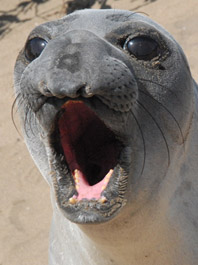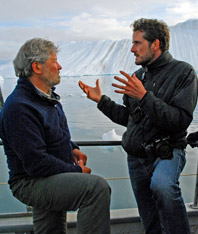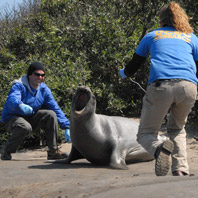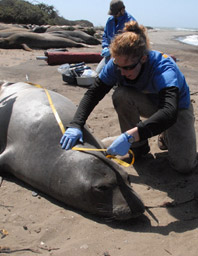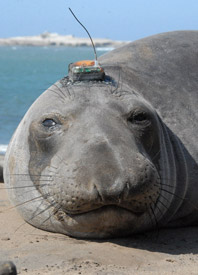The Producer's Story:
Shooting Seals
by Doug Hamilton
In the middle of editing "Ocean Animal Emergency," I flew to
Greenland to shoot part of another upcoming NOVA program.
After months spent filming the spectacular rescue efforts of
seals and sea lions at The Marine Mammal Center in California,
I was taken aback to be in a country where sealskin pelts
decorated my hotel bed and upholstered the benches in the
airport lounge.
For me, it put into perspective the challenge of protecting
wild animals and defending the environment. And it reminded me
that something as seemingly basic as deciding if an animal
merits protection can vary dramatically depending on where you
live. While environmental issues are clearly global, much of
the work must happen at a local level; it's what Tip O'Neill,
the legendary Speaker of the U.S. House of Representatives,
said about the political process: "All politics is local." The
environment is even more so... literally.
Location, location
In Marin County, just north of San Francisco, they spend
millions of dollars a year saving individual animals, but to a
Greenlander seals are common and have historically been a
source of food. So for them eating seal meat and using
sealskins is not very different from what we in the United
States accept as normal with cattle and pigs. These different
perspectives obviously affect how marine animals are treated.
Now, I'm not a vegetarian, or an animal rights person in any
organized sense, but I still can't see how you can spend much
time around a chubby elephant seal pup, with black eyes the
size of billiard balls, and want to turn its fur into a
picture frame. (Seriously, in the hotel gift shop in Greenland
they were selling picture frames made out of seal fur that was
dyed lipstick red.) I know it's a rather lame protest on my
part, but I found myself hiding the sealskin pelts under the
bed before going to sleep.
Which animals engage people's passions depends a lot on where
you live.
In the U.S. our perspective on these animals has changed
significantly in a century. Just over a hundred years ago, we
hunted northern elephant seals for their oil-rich blubber. One
bull male could yield 25 gallons. So extensive was the hunt
that these animals were believed to be extinct. Then in 1892 a
team collecting for the Smithsonian Institution discovered a
small colony of eight on an island off Baja, Mexico. In what
was clearly a wrong-headed effort to preserve these
rare animals, the team shot seven of them for scientific
research. The eighth was spared only because the weather got
bad.
Shortly after this unfortunate incident, the Mexican
government banned the hunting of these animals. The American
government followed suit. Those two government acts saved the
northern elephant seal, and today the population is estimated
to be around 150,000.
Amazingly, recent DNA studies of the existing population
estimate that at its nadir there were probably less than 100
animals left in the world. All of today's population has come
from those few seals. As a result, there is almost no genetic
diversity in the expanded population; it's as if they are all
brothers and sisters. Nearly a century later, the legacy of
our seal-hunting past can still be seen in today's lack of
elephant-seal gene diversity.
A Crashing Effect
Most of the threats to ocean animals today are very different
than a century ago, but as humans increasingly affect the
global environment, new dangers mount even more quickly. In
the last few years, several important international studies
have documented how our oceans are in crisis. Pollution,
overfishing, and global warming are all dramatically changing
them. A few statistics that I came across in my research
shocked me: Ninety percent of the ocean's big fish, like tuna,
have disappeared; 41 percent of the world's oceans have been
seriously degraded by human impact, and last year in the U.S.,
20,000 beaches were temporarily closed or put under advisories
because of pollution.
None of this was, of course, news to Frances Gulland, Director
of Veterinary Science at the Marine Mammal Center. In our
interview, I could almost feel her impatience with having to
convince yet another person of facts that are painfully
obvious in her work every day:
"I'm concerned. I mean it's bad. If you look back to records
from 200 years ago, and read a lot of the new literature out
on how marine life has changed, there are just dramatic
differences in the number of whales and the number of types of
corals and the number of salmon that used to be out there.
This year, for example, there is no recreational salmon
fishery off California, and, you know, 200 years ago you could
walk across the bay on salmon at certain times of the year. So
there are huge changes that have happened. It's pretty
dramatic."
Gulland's veterinarian colleague, Felicia Nutter, has seen
what happens when animal populations crash and are threatened
with extinction. Before coming to the Marine Mammal Center,
she worked for five years with the mountain gorillas in
Rwanda. These animals are clearly A-list stars in the
international wildlife protection movement, but as Felicia
points out, which animals engage people's passions depends a
lot on where you live:
"I think we classify animals like lions in the Serengeti or
mountain gorillas in Rwanda as exotic and really fascinating
and interesting wild animals because we don't spend time with
them. My husband spent a semester at the University of
Tanzania studying zoology, and he was in a classroom full of
Tanzanians, and they were studying the common African species,
which to my husband or me or anybody else who has no
experience with them are really fascinating, elephants and
lions and Cape buffalo. And all those students were like 'Ah,
you know, whatever.' When they got to the bears, you know,
there aren't any bears in Africa, and so they would turn to my
husband and say, 'Yes, lions are great, whatever, but tell us,
are there really such things as bears? Have you seen these
animals?' So, I think we are fascinated by what is not in our
experience."
Paying attention
Frances' experience treating local populations of marine
mammals, and Felicia's ability to articulate why we care about
some animals more than others, helped shape my awareness that
a big reason our environment is in so much trouble is that we
don't pay enough attention to the nature that is right around
us.
It's too easy to dismiss the extraordinary lives of all these
animals and the lessons we can learn from them.
The juxtaposition of filming the rescue of seals in California
one week and sitting on a sealskin-covered bench in Greenland
the next helped me make that connection. But it struck me
again while I was on a much shorter trip down to Año
Nuevo State Natural Reserve in California to film the tagging
of northern elephant seals. I've been on safaris in Kenya,
Australia, and India, and while each of those is spectacular,
seeing the elephant seals at Año Nuevo ranks right up
there with the quality of those foreign wild animal
experiences. Yet this one is just over an hour's drive from my
home in San Francisco. Up until then, I had simply missed it.
This awareness influenced my approach to filming "Ocean Animal
Emergency." I wanted simply to follow several of the animals
that arrived at the Marine Mammal Center and pay close
attention to what happened to them. I hoped that by focusing
on a few that we came to care about, we could better
understand some of the larger trends affecting these
populations.
Extraordinary lives
One particularly sad case, which we highlight in the film, is
the story of Xilia, a harbor seal. After a whole lot of
medical attention and speculation about whether she would make
it, Xilia started to thrive and was successfully released.
They fitted her with a tiny satellite transmitter as part of a
new research program to determine what happens to the released
harbor seals. Sadly, it appears that Xilia got caught up in a
fishing net and was drowned. Her signal started making a
straight line out to sea in the pattern that only a boat would
travel, not a harbor seal. The day I heard that news, it felt
like I had been punched in the stomach.
It's too easy to dismiss the extraordinary lives of all these
animals and the lessons we can learn from them because we just
don't see what they do. Or maybe we just aren't paying
attention. That's too bad, and we are diminished by it.
Felicia reminded me of that very poetically in our interview
when she said that the migration of the northern elephant
seals from Año Nuevo is like the "Serengeti of the Sea."
She's right. It really is out of this world, and yet it was
right under my nose.
